
Back
Nephelium lappaceum L. var. lappaceum
| Family Name: | Sapindaceae |
| Synonyms: | |
| Common Name: | Rambutan, Hairy Lychee, 红毛丹 |
Nephelium lappaceum var. lappaceum or "Rambutan" is a tropical tree that is beloved for its sweet, hairy-looking, red or yellow skinned fruit. Its common name comes from the Malay word "rambut" which means hair, alluding to the hairy appearance of the fruit. Closely related to longan and lychee, this tree bears fruit seasonally and in abundance after a prolonged dry period. The edible aril is white, sweet, juicy and fleshy, surrounding a single large 'woody' seed.
Name
Classifications and Characteristics
| Plant Division | Angiosperms (Flowering Seed Plants) (Dicotyledon) |
|---|---|
| Plant Growth Form | Tree |
| Lifespan (in Singapore) | Perennial |
| Mode of Nutrition | Autotrophic |
| Plant Shape | Rounded |
| Maximum Height | 27 m |
Biogeography
| Native Distribution | Tropical Asia |
|---|---|
| Native Habitat | Terrestrial (Primary Rainforest) |
| Preferred Climate Zone | Tropical |
| Local Conservation Status | Cryptogenic |
Description and Ethnobotany
| Growth Form | It is a tree which can reach up to 27 m tall. |
|---|---|
| Foliage | Leaves are compound, paripinnate and spirally arranged. The leaf stalk (petiole) is 1.5 – 12 cm long. Each leaf comprises of 1 – 5 (– 8) leaflets. They are elliptic (5 – 22 cm long and 2.5 – 10.5 cm wide) and papery texture (papyraceous). The leaflet base is obtuse to rounded while leaflet tip is variable, ranging from obtuse to acuminate, or sometimes notched (emarginate) or cuneate. The upper surface of the leaflet is mostly glabrous while the underside can be glabrous or covered with appressed short hairs. The domatia are usually present. |
| Flowers | Inflorescence occur as a long spike (thyrsoid) at the axillary or pseudo terminal position. The inflorescence comprises of many small cream to yellowish green flowers. The flowers have 5 – 8 stamens. |
| Fruit | The fruit is ellipsoid to subglobular (up to 6 cm long and 3.5 cm wide) and covered with tapering appendages, which can reach up to 2 cm long. The fruit is fleshy and turns red when ripe. The seed is surrounded with an edible white fleshy sarcostesta. |
| Habitat | It is found in rainforest, mainly on fertile sandy soils, up to 600 m (–1300 m) altitude. |
| Associated Fauna | Flowers are pollinated by insects, such as bees and butterflies. The fruit are eaten mainly by primates, flying foxes, fruit bats and squirrels. |
| Cultivation | It can be propagated by seed, grafting and marcotting. Cultivated trees are observed to bloom twice a year. |
| Etymology | Genus epithet 'Nephelium', in Greek, means a little cloud, which refers to the fruit. Specific epithet ‘lappaceus’, in Latin, means burr-like, which refers to the fruit appendages. |
| Ethnobotanical Uses | Edible Plant Parts : Edible Fruits Food (Fruit or Vegetable): The white juicy sarcotesta of the fruit is edible, sweet-tasting and rich in Vitamin C, ranging from 22 to 47 mg per 100 g for Hawaii-grown rambutan cultivars <6>. The sarcotesta can be is eaten fresh, canned in syrup, cooked in stew or dehydrated as chips <3>. Others: It is commonly cultivated as a fruit tree. Traditional Medicinal Uses In Malaysia, various plant parts are traditionally used by local villagers to treat a variety of conditions. The roots were used in a decoction for treating fever, the leaves were used for poulticing and the bark for an astringent for tongue <3>. It is important to note that some therapeutic effects from traditional medicinal uses of plants are currently not supported or verified by scientific research. |
Landscaping Features
| Desirable Plant Features | Ornamental Fruits |
|---|---|
| Landscape Uses | General |
| Thematic Landscaping | Economic Garden, Naturalistic Garden |
Fauna, Pollination and Dispersal
| Fauna Pollination Dispersal Associated Fauna | Bird-Attracting, Butterfly Host Plant |
|---|---|
| Pollination Method(s) | Biotic (Fauna) (Insects (Bee), Insects (Butterfly, Moth), Insects (Ant, Beetle, Fly, Thrip, Wasp)) |
Plant Care and Propagation
| Light Preference | Full Sun |
|---|---|
| Water Preference | Moderate Water |
| Plant Growth Rate | Moderate |
| Rootzone Tolerance | Fertile Loamy Soils |
| Maintenance Requirements | Moderate |
| Propagation Method | Seed, Grafting, Marcotting |
| Propagation Method Remarks | Trees grown from seed bear fruits in 5-6 years. Grafted and marcotted trees fruit in 2-4 years. |
Foliar
| Foliage Retention | Evergreen |
|---|---|
| Mature Foliage Colour(s) | Green |
| Mature Foliage Texture(s) | Papery |
| Foliar Type | Compound |
| Foliar Arrangement Along Stem | Alternate |
| Foliar Attachment to Stem | Petiolate |
| Foliar Shape(s) | Non-Palm Foliage (Elliptical) |
| Foliar Venation | Pinnate / Net |
| Foliar Margin | Entire |
| Typical Foliar Area | Notophyll ( 20.25cm2 - 45 cm2 ) |
| Leaf Area Index (LAI) for Green Plot Ratio | 3.0 (Tree - Intermediate Canopy) |
Non - Foliar and Storage
| Trunk Type (Non Palm) | Woody |
|---|---|
| Mature Bark Texture | Smooth |
| Stem Type & Modification | Woody |
| Root Type | Underground |
Floral (Angiosperm)
| Flower Colour(s) | Cream / Off-White, Green |
|---|---|
| Flower Grouping | Cluster / Inflorescence |
| Flower Location | Axillary |
| Inflorescence Type | Thyrse |
| Flowering Habit | Polycarpic |
Fruit, Seed and Spore
| Mature Fruit Colour(s) | Red |
|---|---|
| Fruit Classification | Simple Fruit |
| Fruit Type | Fleshy Fruit , Drupe |
| Seed Quantity Per Fruit | Few (1-5) |
References
| References | <1> Adema, F., Leenhouts, P.W. & van Welzen, P.C. (1994). Sapindaceae. In: Kalkman, C. et al (eds) Flora Malesiana, ser. 1, vol. 11 (3), pp. 419–768. Leiden: Rijksherbarium/Hortus Botanicus, Leiden University <2> Leehouts, P.W. (1986). A revision of Nephelium (Sapindaceae). Blumea 31 (2): 373 – 436 <3> Lim, T.K. (2013). Edible Medicinal and Non-Medicinal Plants, Vol. 6, Fruits. Dordrecht: Springer <4> van Welzen, P.C. (2017). Sapindaceae. In: Kiew, R. et al (eds) Flora of Peninsular Malaysia Series II: Seed Plants vol. 6, pp. 63–191. Kuala Lumpur: Forest Research Institute Malaysia <5> van Welzen, P.C. (1999). Sapindaceae. In: Santisuk, T. & Larsen, K. (eds) Flora of Thailand, vol. 7(1), pp. 169–250. Bangkok: Forest Herbarium, Royal Forest Department |
|---|
Image Repository
Others
| Master ID | 1749 |
|---|---|
| Species ID | 3042 |













